Rajasthani cuisine, an intricate tapestry woven from the arid landscapes of northwest India, celebrates regal flavors crafted from local ingredients. The culinary artistry shines in the harmony of textures, where wheat rolls and coarsely ground wheat coalesce, and gram flour dumplings pirouette in spiced yogurt. A unique blend of berries, beans, and the regal influence of fiery creations like Lal Maas add an exotic touch to the culinary canvas. The indulgent notes of Dal Baati Churma and the comforting embrace of Kadhi showcase the depth and variety of Rajasthani culinary heritage. Each meal becomes a majestic exploration, a tribute to the region's rich and diverse flavors.
Kulfi
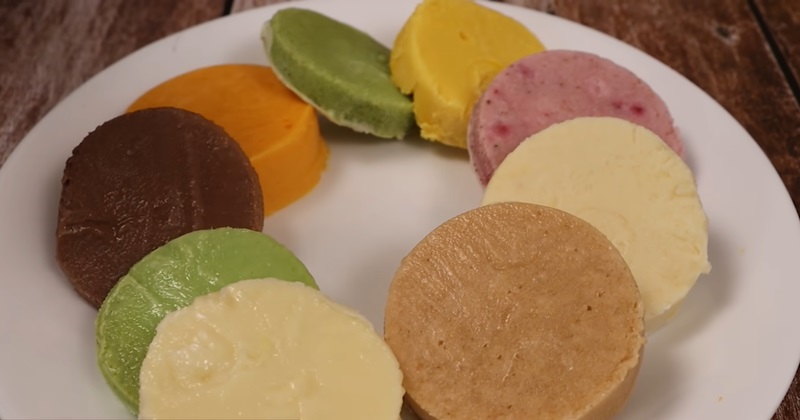
Kulfi is a popular frozen dessert that originates from the state of Rajasthan in India. It is a traditional sweet dish that is loved by people of all ages. Kulfi is made by boiling milk and reducing it to a thick consistency. It is then sweetened with sugar and flavored with cardamom, saffron, and other aromatic spices. What makes Rajasthani kulfi unique is its rich and creamy texture. Unlike regular ice cream, kulfi is denser and has a more intense flavor. It is traditionally frozen in small, conical-shaped molds called matkas, which adds to its authenticity. In addition to the classic flavors, Rajasthani kulfi also comes in a variety of fruity and nutty variations. Some popular flavors include mango, pistachio, almond, and rose. It is often garnished with crushed nuts like almonds and pistachios, giving it a delightful crunch. Kulfi is enjoyed on its own as a refreshing dessert, or it can be served alongside traditional Indian sweets like jalebi or falooda. It is a perfect treat to beat the summer heat and is often savored during festive occasions and celebrations. Rajasthani kulfi is a must-try for anyone looking to experience the flavors of Rajasthan's rich culinary heritage.
Rajasthani Thali
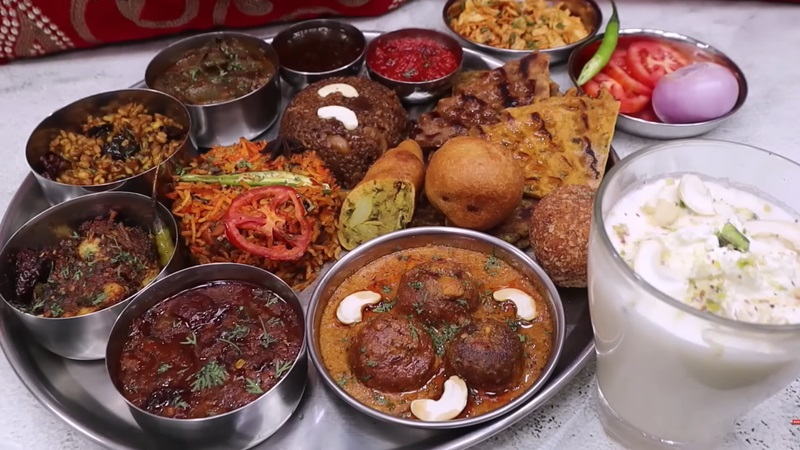
Rajasthani cuisine, renowned for its opulence and flavorful creations, unfolds its culinary splendor through the Rajasthani Thali—a traditional Indian feast presented on an expansive platter. This vibrant culinary ensemble offers a kaleidoscope of flavors, featuring both vegetarian and non-vegetarian delights. At the heart of the Rajasthani Thali is the iconic Dal Baati Churma, a medley of lentils, baked wheat balls, and sweet crumbled wheat—a quintessential Rajasthani staple. The Thali further dazzles with Gatte ki Sabzi, a spicy gram flour dumpling curry, Ker Sangri, a tangy and spicy dessert bean and berry dish, and Laal Maas, a fiery red mutton curry infused with aromatic spices. Accompanied by an assortment of bread like Bajra Roti, Makki ki Roti, and Puri, the Thali completes its offering with a variety of condiments, including chutneys, pickles, and papads. The grand finale of this culinary journey includes an array of sweets like Ghevar, Malpua, and Mawa Kachori, striking a perfect balance of flavors. With its diverse range of dishes, textures, and flavors, the Rajasthani Thali mirrors the rich and vibrant culture of Rajasthan, leaving gastronomes yearning for another delightful encounter.
Kachori
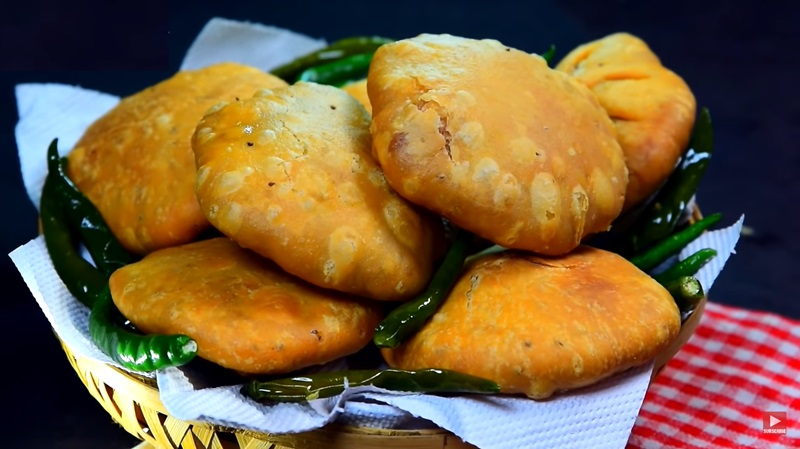
Rajasthani cuisine, celebrated for its opulent flavors and distinctive culinary creations, boasts the Kachori as one of its culinary gems. This deep-fried pastry stands out as a versatile delight, fittingly enjoyed as a snack or incorporated into a main meal. Crafting Kachori involves filling a dough, crafted from flour, oil, and water, with a flavorful blend of lentils, spices, and sometimes vegetables. The filled dough is then meticulously sealed and deep-fried until it achieves a golden-brown, crispy perfection. Resulting in a delectable treat with a crunchy exterior enveloping a flavorful, aromatic filling, Rajasthani cuisine offers various Kachori variations. Among these, the dal kachori features a spiced lentil mixture, while the pyaaz kachori delights with a blend of onions and spices. Often accompanied by tangy chutneys or a side of yogurt, Kachori is a sensory delight, appealing not just to the taste buds but also with its golden hue and inviting aroma. For those eager to explore the flavors of Rajasthani cuisine, Kachori is a must-try, encapsulating the richness and uniqueness of this culinary tradition.
Ghevar
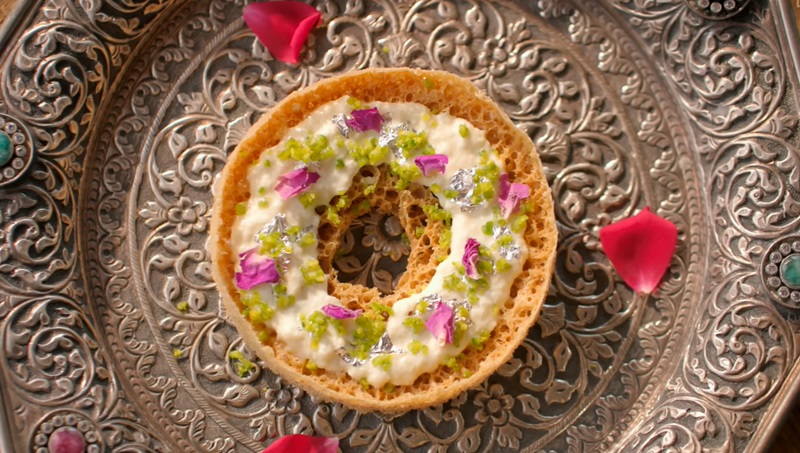
Ghevar, a beloved Rajasthani sweet, holds a special place in festive and celebratory occasions. Revered across generations, this intricate dessert is crafted from a batter of refined flour, ghee, and water, deep-fried to form a crispy, porous disc. After frying, it undergoes a sweet transformation as it is delicately soaked in sugar syrup, enhancing its sweetness and tenderness. Ghevar is adorned with toppings like saffron strands, chopped nuts, and occasionally a dollop of rabri or condensed milk. Renowned for its delicate and elaborate design, achieved through a specific pouring technique to create layers and holes, Ghevar emerges as a visually stunning dessert, as delightful to the eyes as it is to the palate. Enjoyed on its own as a sweet indulgence, it is also paired harmoniously with a scoop of ice cream or a drizzle of malai. For those exploring Rajasthan, Ghevar is an essential culinary experience, offering a taste of the region's rich and vibrant flavors during festivities and beyond.
Bhakri
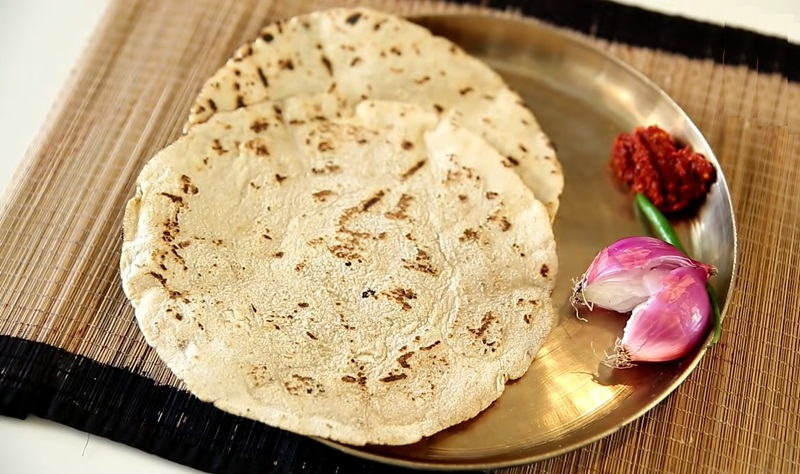
Rajasthani cuisine, celebrated for its opulence and flavors, boasts the traditional flatbread known as Bhakri. Made from coarse wheat flour, specifically bajra or millet flour, Bhakri stands as a staple in Rajasthan. Often served alongside various curries and accompaniments, the preparation involves mixing bajra flour with water, creating a stiff dough. Divided into portions, the dough is rolled into round discs and cooked on a hot griddle until achieving a golden-brown, crispy texture. Best enjoyed hot, straight off the griddle, Bhakris contribute a unique taste and texture to any Rajasthani meal. The earthy flavor of Bhakri complements the spicy and tangy curries typical of Rajasthan. Additionally, Bhakri is a nutritious choice, being gluten-free and rich in essential nutrients. A quintessential Rajasthani dish, Bhakri embodies the region's culinary heritage with its simplicity and versatility, earning favor among both locals and visitors alike.
Dal Baati
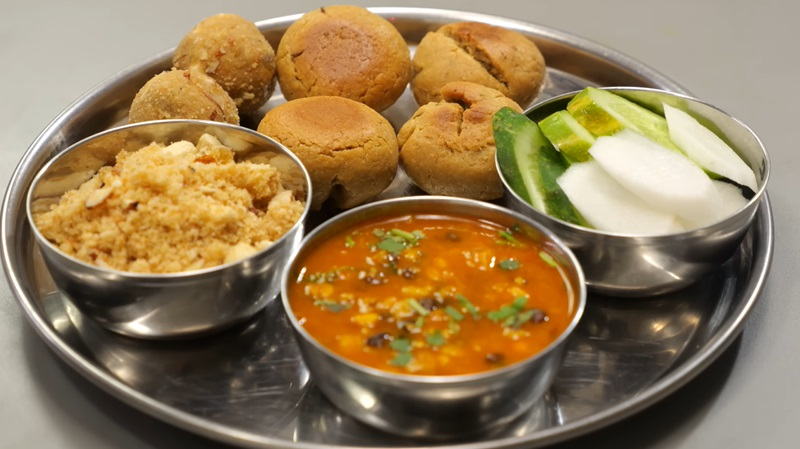
Dal Baati, a quintessential delight from Rajasthan, captures the essence of the region's rich culinary culture with its core components: dal and baati. The dal incorporates urad dal, chana dal, mung dal, moth dal, or, tuvar dal cooked together after soaking in water. In a frying pan, vegetable oil is heated, and mustard-cumin seed seasoning (rai-jeera) is added. Green chili, garlic, and spices like turmeric, asafoetida, red chili, coriander, and ginger follow. Some regions may feature a sweet and sour version of the dal, concluding with the addition of boiled dal. Baati, a sturdy bread made from wheat flour (aata), involves kneading with salt, dahi (yogurt), and water. Tennis ball-sized dough rounds are cooked in a well-heated traditional oven or earthen stove, greased with ghee until golden brown, and served with kairi (raw mango) chutney, daal, rava laddoo, garlic chutney, rice, pudina chutney, green salad with ample onions, and fresh buttermilk.
Kadhi
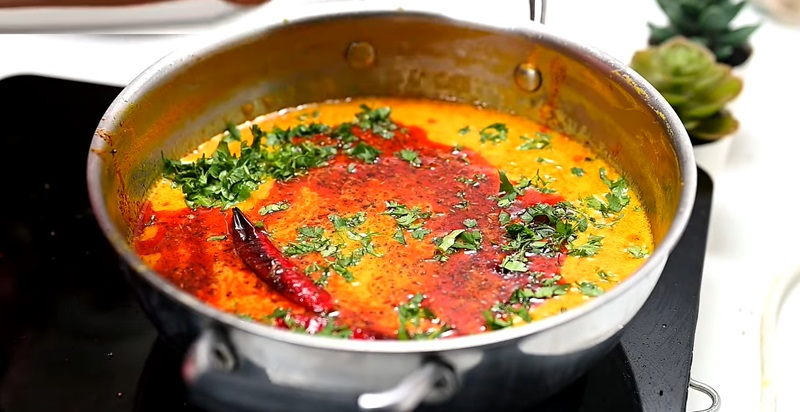
Rajasthani cuisine is known for its rich and vibrant flavors, and one of its most popular dishes is Kadhi. Kadhi is a thick and creamy yogurt-based curry that is typically served with steamed rice or roti. To prepare Kadhi, a mixture of yogurt, gram flour (besan), and spices like turmeric, red chili powder, and coriander powder is cooked until it thickens. This mixture is then tempered with mustard seeds, cumin seeds, fenugreek seeds, and dried red chilies in hot ghee or oil, which adds a delicious aroma to the dish. The final step is to add water to the mixture and let it simmer until it reaches the desired consistency. The result is a creamy and tangy curry that is perfectly balanced with the warmth of spices. Kadhi is often garnished with fresh coriander leaves and served hot. It is a comfort food that is loved by people of all ages in Rajasthan. The creamy texture and tangy flavor make it a perfect accompaniment to rice or roti, and it is often enjoyed as a main course or as a side dish in Rajasthani meals.
Bikaneri Bhujia
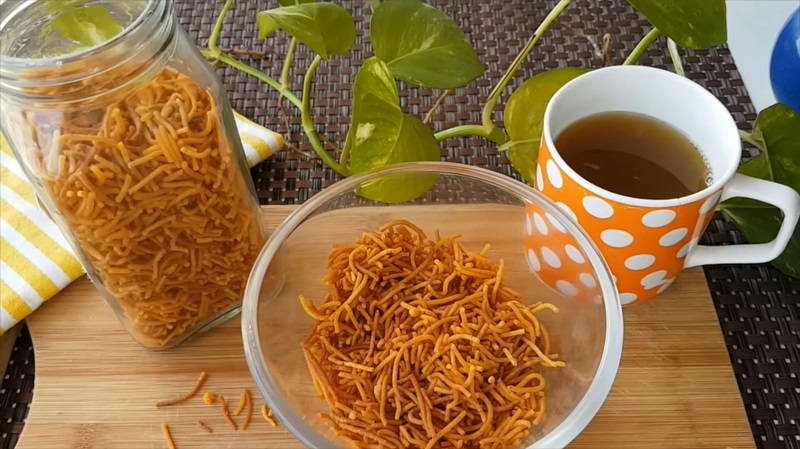
Bikaneri bhujia, a delectable snack originating from Rajasthan, India, is known for its popularity and mouth-watering appeal. This savory delight is crafted from a dough made of gram flour, moth bean, garbanzo bean, and an array of spices such as red chilli, powdered cellulose, salt, cardamom, black pepper, cloves, among others. The preparation involves pressing the dough through a sieve and deep-frying it in vegetable oil to achieve the snack's distinctive texture and flavor. The result is a crispy and flavorful treat that embodies the culinary richness of Rajasthan, offering a delightful combination of spices and ingredients that make Bikaneri bhujia a cherished snack enjoyed by many.
Kalakand
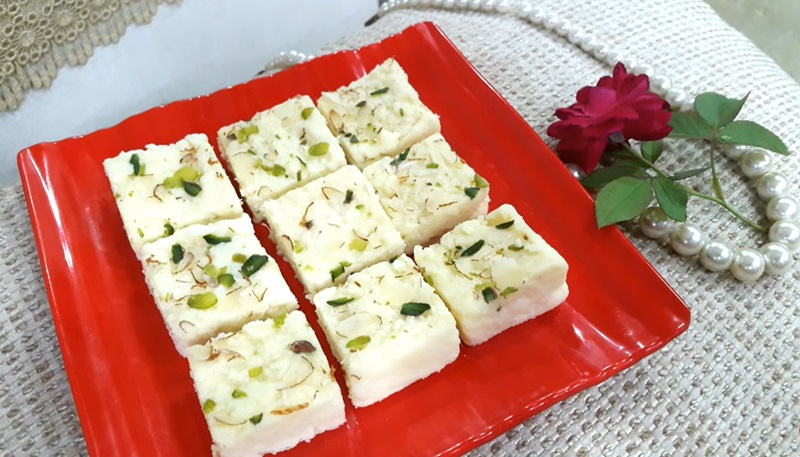
Kalakand, a cherished sweet from Rajasthan, India, is renowned for its richness and irresistible flavor. The preparation involves making chhena (Indian cheese) and straining it. Simultaneously, whole milk and water are boiled, stirred until halved in volume. The strained chhena is softened and added to the reduced milk-water, forming a thick paste. Sugar is incorporated, and the mixture is cooked until it reaches a fudge-like consistency. Ghee or butter is then introduced, cooking until a glossy appearance is achieved. The final mixture is spread onto a buttered tray, forming a rectangle, and adorned with pistachios. After cooling, it is cut into squares, presenting a delightful and indulgent treat that showcases the culinary excellence of Rajasthan, perfect for celebrations and special moments.
Boondi
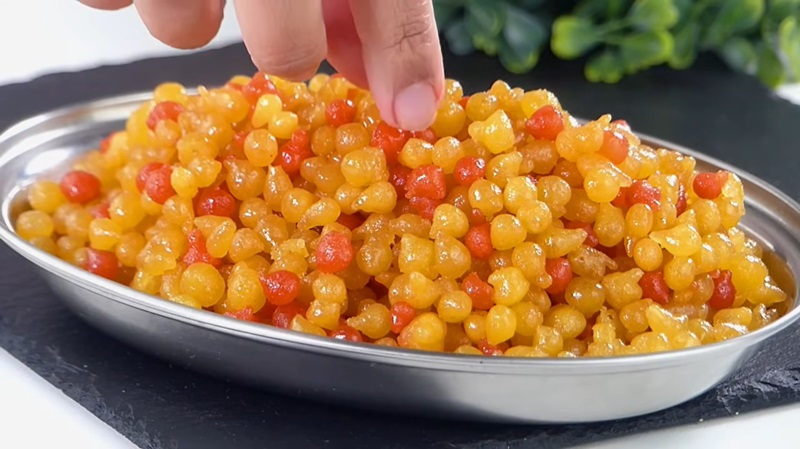
Boondi, an Indian snack, is crafted from fried chickpea flour and enjoyed in both savory and sweet variations. For the crispy savory version, a batter of chickpea flour, baking powder, and turmeric is created. Small drops are poured into hot oil using a slotted spoon, resulting in fried boondi, which is then soaked in sugar syrup. Crushed curry leaves add an extra layer of flavor. Khara boondi, the savory variant, is relished on its own or included in Indian mixtures. Boondi is widely used in North India to prepare raita, featuring curd, softened boondi, and seasonings like salt, chili, and spices. This refreshing side dish complements pulao and various meals, showcasing the versatility of boondi in Indian cuisine.
Laal Maans
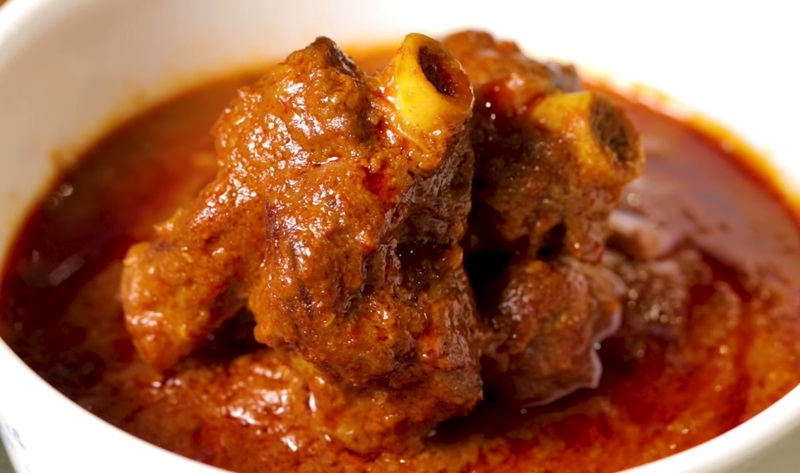
Laal Maans, a traditional Rajasthani dish, is a fiery and delectable mutton curry that is known for its rich flavors and vibrant red color. The name "Laal Maans" translates to "red meat" in English, which perfectly describes the dish's appearance and taste. The key ingredient in this dish is mutton, which is marinated in a blend of various spices like red chili powder, turmeric, coriander, and garam masala. The meat is slow-cooked in a thick gravy made from yogurt, onions, garlic, and tomatoes, which gives it a tangy and savory flavor. Laal Maans is known for its intense spiciness, which is balanced by the richness of the gravy and the tenderness of the meat. It is usually served with Indian breads like roti or naan, and sometimes accompanied by rice or biryani.
Makki Ki Roti
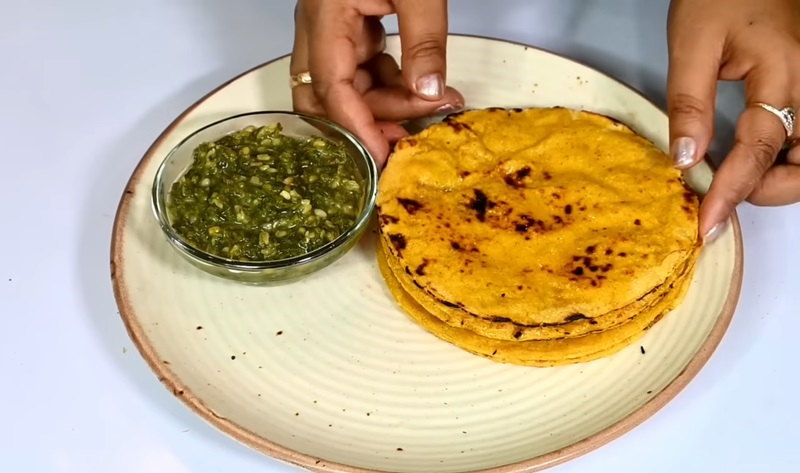
Makki ki roti is a traditional dish from the culturally rich state of Rajasthan in India. It is a popular dish made from maize flour, also known as cornmeal, and is a staple in Rajasthani cuisine. The dish reflects the agricultural heritage of the region, where maize is commonly grown. To prepare makki ki roti, the maize flour is mixed with water and kneaded into a dough. The dough is then rolled out into flat, round breads, similar to rotis or chapatis. These rotis are typically cooked on a hot griddle or tawa with a little bit of ghee or oil. Makki ki roti is best enjoyed with a variety of accompaniments, such as sarson ka saag (a delicious mustard greens curry), pickles, yogurt, or even a dollop of butter. The earthy, slightly sweet taste of the maize flour adds a unique flavor to the dish, making it a favorite amongst locals and tourists alike.
Mathri
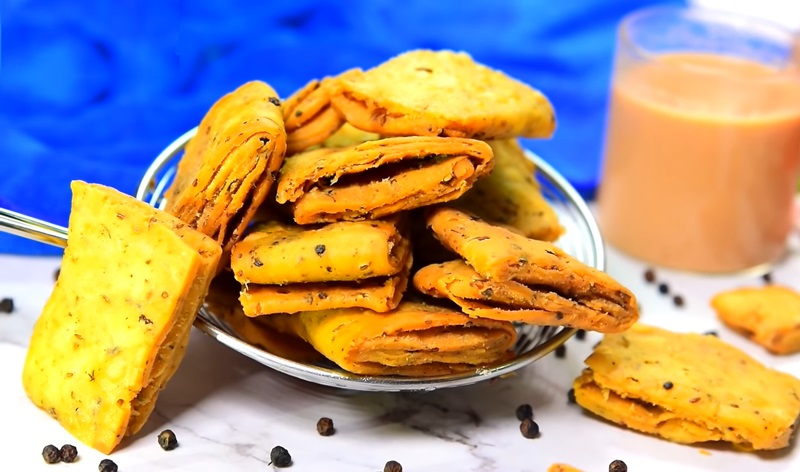
Mathri, a beloved Rajasthani snack cherished throughout India, is a crispy and savory biscuit crafted with a blend of flour, ghee, and spices. The dough takes shape in small, round forms, deep-fried to a golden-brown crispiness. This versatile treat finds companionship in a hot cup of tea or as a side to various Rajasthani dishes. Whether relished alone or paired with diverse chutneys and pickles, mathri's spice profile, featuring ajwain (carom seeds), cumin seeds, and black pepper, caters to individual tastes. Mathri's distinctive flaky and crunchy texture, achieved through the inclusion of ghee in the dough, sets it apart. The ghee imparts a rich, buttery flavor, rendering mathri utterly irresistible.
Laapsi
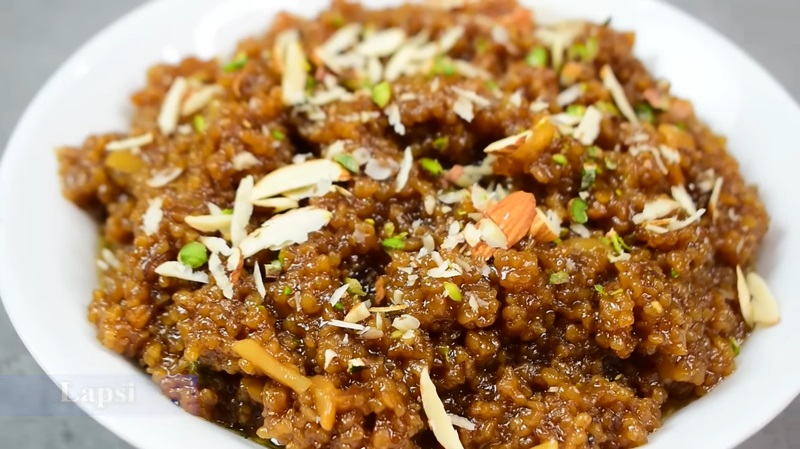
Laapsi, a cherished sweet in Rajasthani cuisine, is a delectable creation involving broken wheat, ghee (clarified butter), jaggery (unrefined sugar), and an array of nuts. This sweet dish holds a special significance in Rajasthani culinary traditions, frequently gracing festivals and auspicious occasions. The preparation begins with roasting broken wheat in ghee until it takes on a golden-brown hue, emitting a delightful nutty aroma. Subsequently, water is introduced, and the wheat is simmered to attain a soft and tender consistency. The addition of melted jaggery imparts a rich, sweet flavor, complemented by the aromatic essence of cardamom powder and a generous blend of chopped nuts such as almonds, cashews, and raisins.
Mohanthal
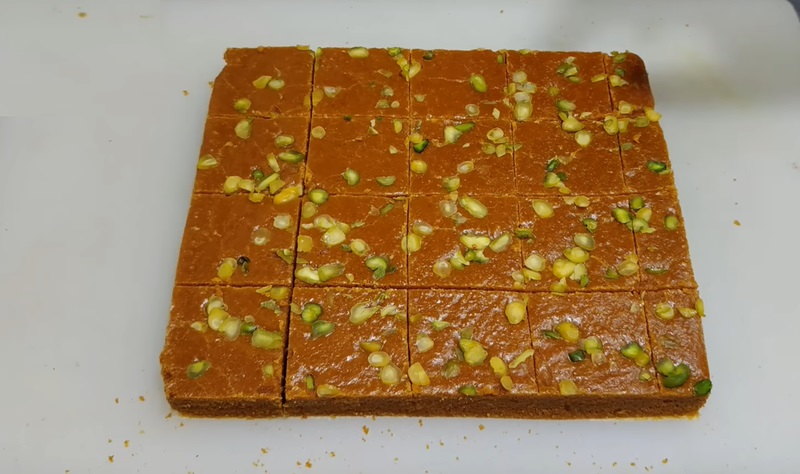
Mohanthal, a revered sweet dish from Rajasthan, takes center stage in Rajasthani cuisine, especially during festivals and special occasions. This delectable dessert boasts a blend of besan (gram flour), ghee (clarified butter), sugar, and a medley of nuts like almonds and pistachios. The journey begins with besan undergoing a golden-brown transformation in ghee, acquiring a rich nutty essence. The roasted besan harmonizes with a sugar syrup, crafted by boiling sugar and water into a thick consistency. The resulting amalgamation is carefully poured into a greased tray and adorned with chopped nuts. After cooling, Mohanthal is meticulously cut into diamond-shaped pieces for serving. Its texture is dense yet slightly crumbly, offering a melt-in-your-mouth experience. Known for its distinctive fusion of sweet and nutty flavors, Mohanthal captivates dessert enthusiasts.
Dal Bati Churma
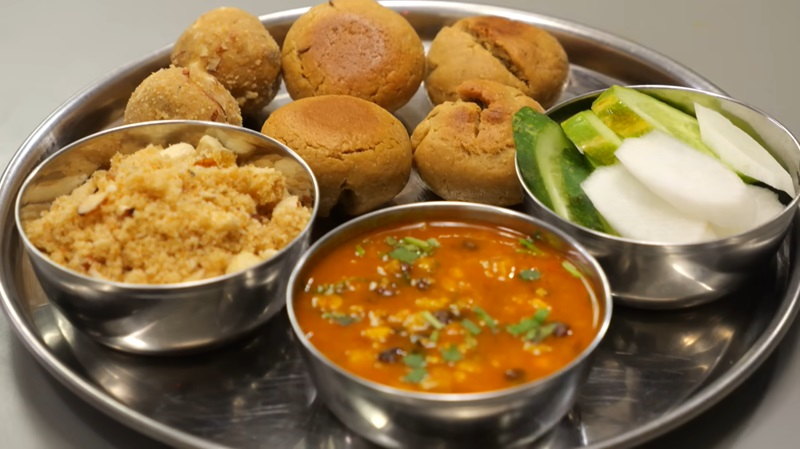
Dal Bati Churma is a traditional and iconic dish from the royal state of Rajasthan in India. This delectable dish consists of three main components: dal (lentil curry), bati (baked wheat dough balls), and churma (sweet crumbled wheat). The dal is made from a combination of lentils, such as tuvar dal, moong dal, or chana dal, which are cooked with aromatic spices like cumin, turmeric, and garam masala. The result is a rich and flavorful lentil curry that is usually served with rice or roti. The batis are round bread rolls made from wheat flour, ghee (clarified butter), and yogurt. These batis are usually served with ghee on top. Churma is a sweet crumbled wheat dish made by crushing the baked batis and mixing them with ghee, sugar, and cardamom powder. It adds a delightful sweet and crunchy element to the meal. Dal Bati Churma is often enjoyed with a side of pickles, buttermilk, and salad. It is a wholesome and filling dish that showcases the rich flavors and culinary traditions of Rajasthan.
Dal Dhokli
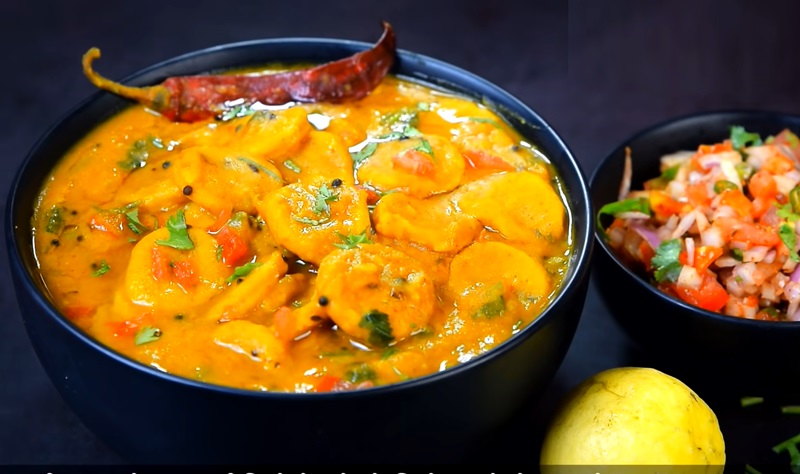
Dal Dhokli is a traditional Rajasthani dish that is loved for its comforting flavors and hearty ingredients. It is a one-pot meal that combines lentils, spices, and wheat flour dumplings called dhokli. To prepare Dal Dhokli, first, a flavorful lentil soup, known as dal, is cooked using ingredients like pigeon pea lentils, tomatoes, and a blend of aromatic spices. The lentils are simmered until they are tender and the flavors have melded together. Next, small pieces of dough made from wheat flour, turmeric, and spices are rolled out and added to the simmering dal. These dumplings, called dhokli, are cooked until they are soft and infused with the flavors of the dal. The final dish is a beautiful combination of soft and chewy dumplings in a thick, flavorful lentil soup. It is often garnished with fresh coriander leaves and served with a side of yogurt or pickle.
Aam Panna
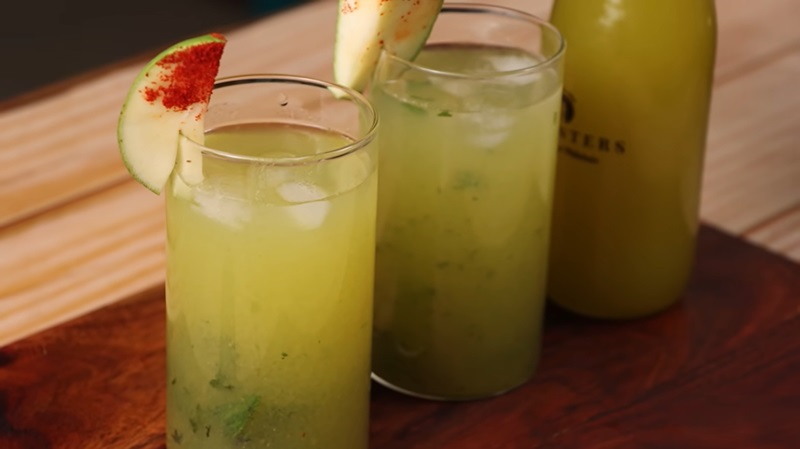
Rajasthani cuisine is known for its rich flavors and unique combination of spices. One popular dish that showcases the essence of this cuisine is Aam panna, a refreshing beverage made from raw mangoes. Aam panna is a summer delight that provides relief from the scorching heat. The main ingredient, raw mangoes, is boiled and then pureed to create a tangy and slightly sweet base. This is then spiced up with a blend of roasted cumin powder, black salt, and black pepper, giving it a distinctive Rajasthani twist. To make Aam panna even more refreshing, it is often served chilled with a few ice cubes and garnished with fresh mint leaves. The drink is not only delicious but also has several health benefits. Raw mangoes are rich in Vitamin C and provide a cooling effect on the body. Aam panna is not just a popular beverage in Rajasthan but is enjoyed throughout India. Its tangy and rejuvenating taste makes it a perfect summer cooler for everyone to beat the heat. So, next time you are looking for a refreshing drink, give Aam panna a try and experience the flavors of Rajasthan.
Mirchi Bada
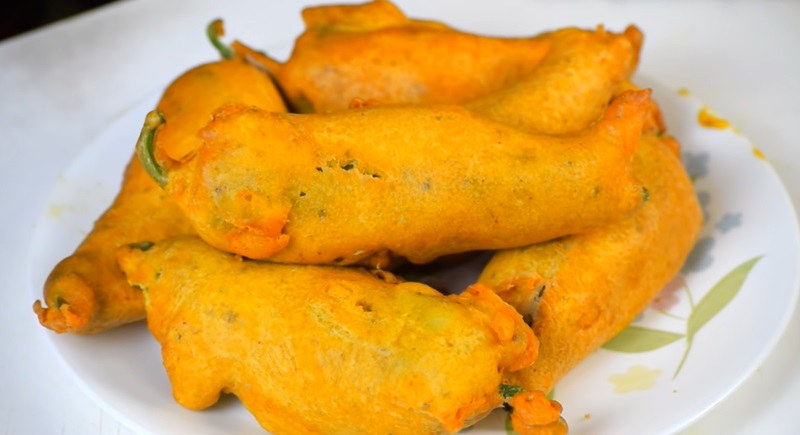
Mirchi Bada is a popular Rajasthani dish that tantalizes the taste buds with its spicy and flavorful ingredients. Mirchi Bada is made using large green chilies that are slit and stuffed with a mixture of gram flour (besan), spices, and herbs. The chilies are then deep-fried until they turn golden and crispy. The gram flour coating gives it a crunchy texture, while the spice mixture adds a burst of flavor. The dish is typically served hot with a side of tangy tamarind or mint chutney. The combination of the crispy outer layer and the spicy stuffing creates a mouthwatering experience for food lovers. Mirchi Bada is a popular street food in Rajasthan and is often enjoyed as a snack or appetizer. It is known for its fiery taste, making it a favorite among spice lovers. The dish reflects the rich culinary heritage of Rajasthan and is a must-try for anyone exploring the vibrant flavors of Rajasthani cuisine.
Panchratna Dal
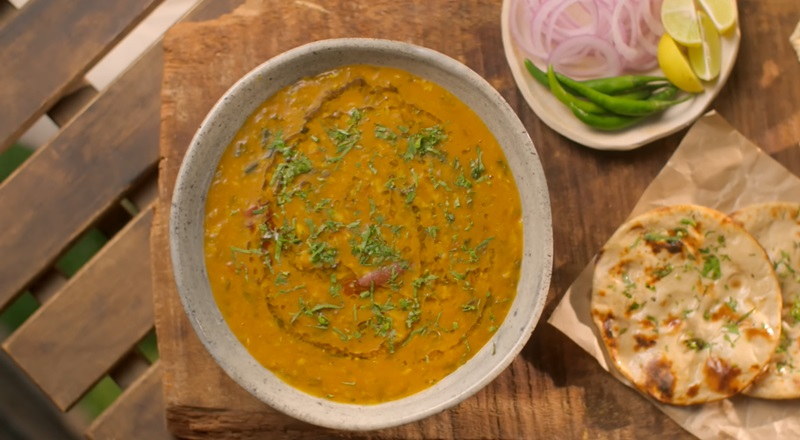
Panchratna Dal is a traditional Rajasthani dish that showcases the rich flavors and textures of Rajasthan cuisine. The name "Panchratna" translates to "five jewels," which refers to the five different lentils used in this dish. To prepare Panchratna Dal, a mix of five lentils – chana dal, toor dal, moong dal, urad dal, and masoor dal – are cooked together until they become tender and creamy. The lentils are then seasoned with a blend of aromatic spices like cumin, coriander, turmeric, and garam masala, which adds a depth of flavor to the dish. The dish is often garnished with a tempering of ghee, mustard seeds, cumin seeds, and dried red chilies, which adds a smoky and spicy kick to the dal. It is usually served hot with steamed rice or roti.
Kanda Kachauri
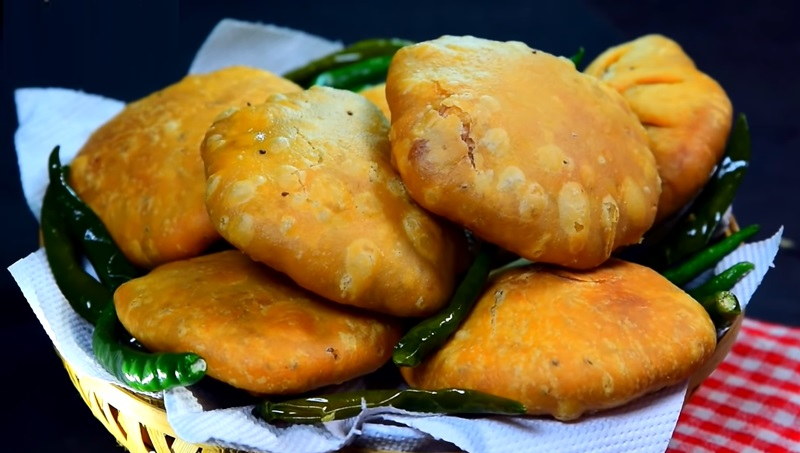
Kanda Kachauri, a variant of Rajasthani Kachori, stands out as a fried pastry featuring a spicy onion filling. Its popularity expanded beyond Rajasthan with the emergence of Rajasthani restaurants and food outlets throughout North India. A favored morning breakfast in Rajasthan, these circular Kande ki Kachoris are cherished by a large number of people. Steaming hot and filled with spicy goodness, Kande ki Kachori has become a staple available in numerous namkeen shops across the state. The distinct flavors and aromatic appeal of this delightful snack have contributed to its widespread recognition, making it a sought-after choice for those craving a flavorful and satisfying start to their day in the vibrant culinary landscape of Rajasthan.
Papad ki Saag-Bhaaji
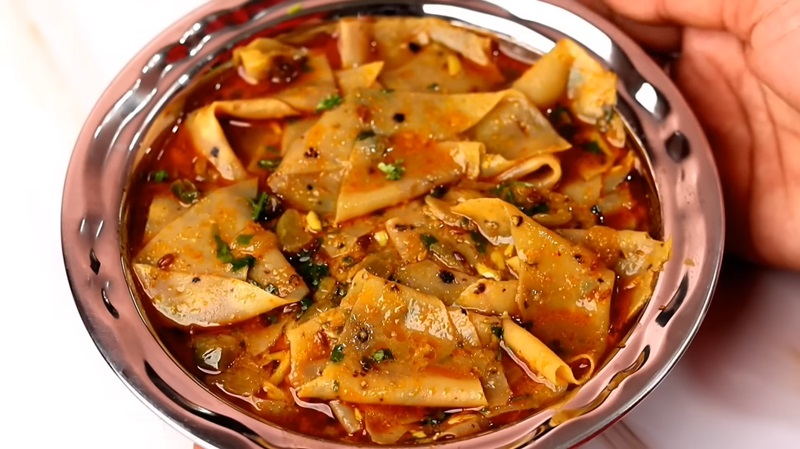
Papad ki Bhaaji, also known as Papad ka Saag, is a vegetarian main course dish celebrated in Rajasthani and various Indian cuisines. This flavorful dish can be easily crafted at home using minimal ingredients, making it a simple yet fulfilling meal, particularly suited for sustaining amidst the challenges of desert life. In addition to its role as a main course, papad is enjoyed in India as an appetizer or snack. Served with toppings like chutney, carrots, chopped onions, or other dips and condiments, it becomes a versatile and delightful treat that reflects the diverse culinary traditions found across the country.
Dal Badam Chakki

Dal Badam Chakki, also known as Dal Suphal Chakki, is a Rajasthani dessert hailing from the Marwari cuisine, particularly renowned in Jodhpur. This delicacy features a combination of lentil (dal) and almond (badam), showcasing the unique culinary expertise of the region. The key components of Dal Badam Chakki include moong dal flour or mogar (gram flour), ghee (clarified butter), almonds, mawa (condensed milk), and sugar. This delightful dessert harmoniously blends the richness of almonds with the nuttiness of gram flour, creating a sweet and flavorful treat. Dal Badam Chakki stands out as a specialty dessert, reflecting the cultural and gastronomic heritage of Rajasthan, especially in the vibrant city of Jodhpur.
Jhajariya
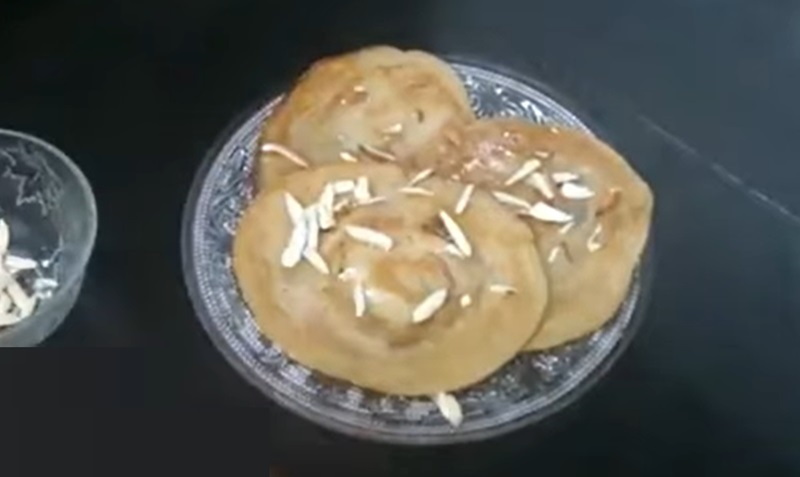
Jhajhariya, a delectable delicacy, is a confluence of sugar, corn, ghee, and milk, and is adorned with raisins and nuts. The preparation involves slowly roasting grated or coarsely ground fresh sweet corn in ghee over a span of a few hours. During this process, the corn gradually loses its moisture and transforms into a dry, granular texture, resulting in the distinctive character of Jhajhariya. This culinary creation showcases a harmonious blend of the natural sweetness of corn, the richness of milk, and the indulgence of ghee, culminating in a delightful treat. Adorned with raisins and nuts, Jhajhariya stands as a testament to the culinary artistry that brings together flavors and textures in a unique and delightful manner.
Katt Bafla
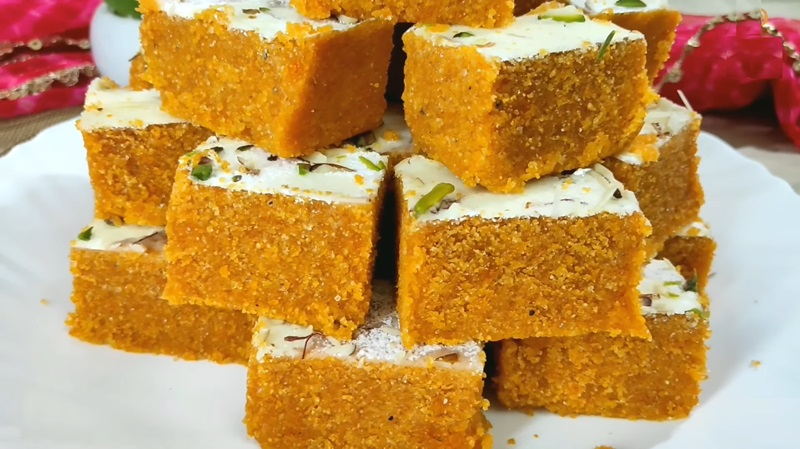
Katt Bafla, a renowned and traditional delicacy originating from the Bundi district in the Hadoti region of Rajasthan, India, has gained popularity across North Indian states. This dish holds a significant place in Rajasthan's culinary traditions, being prepared on various occasions. The term "Bafla" refers to a spherical wheat bread, while "Katt" represents a Barfi crafted from a blend of unsalted wheat bread coarse powder, ghee, and jaggery powder. This unique combination showcases the culinary artistry of the region, blending the textures of wheat bread with the sweet richness of Barfi. Celebrated for its distinct flavors, Katt Bafla has become a cherished dish, symbolizing the cultural richness and festive traditions of Rajasthan.
Dal
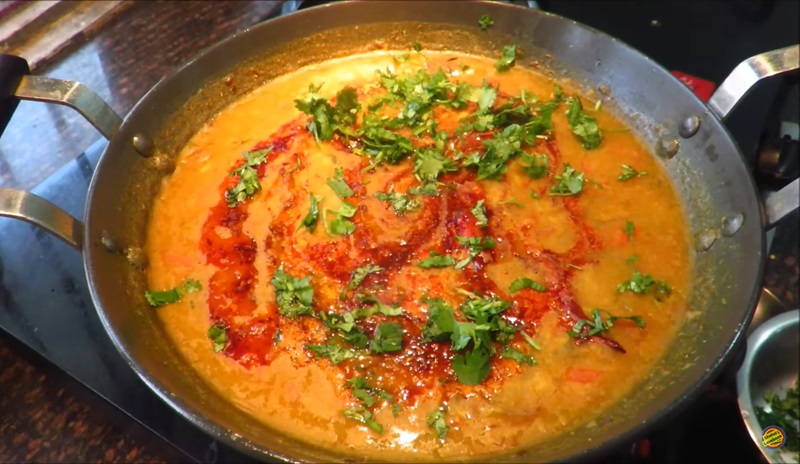
Rajasthani cuisine stands out for its opulent and lively flavors, with one of its culinary gems being the renowned Dal Dish. Dal, an essential ingredient in Indian cooking, manifests itself in diverse forms across regions. In Rajasthan, the Dal Dish takes on a distinctive and flavorful character. This dish is crafted using a blend of lentils, including chana dal, toor dal, and moong dal. After soaking, the lentils are cooked with a medley of aromatic spices—cumin, coriander, turmeric, and red chili powder—resulting in a robust and thick lentil stew bursting with flavors. What sets the Rajasthani Dal Dish apart is its tempering technique. Ghee, cumin seeds, asafoetida, and dried red chilies are expertly added to the cooked lentils, infusing them with a unique and tantalizing aroma. This tempering elevates the dal, introducing a delightful smoky and spicy element to the dish. Typically paired with steamed rice or Indian bread like roti or naan, the Rajasthani Dal Dish offers a comforting and nourishing experience cherished by locals and visitors alike. Whether a vegetarian or someone seeking a wholesome and flavorful meal, this dish is certain to gratify your taste buds.
Palak Paneer
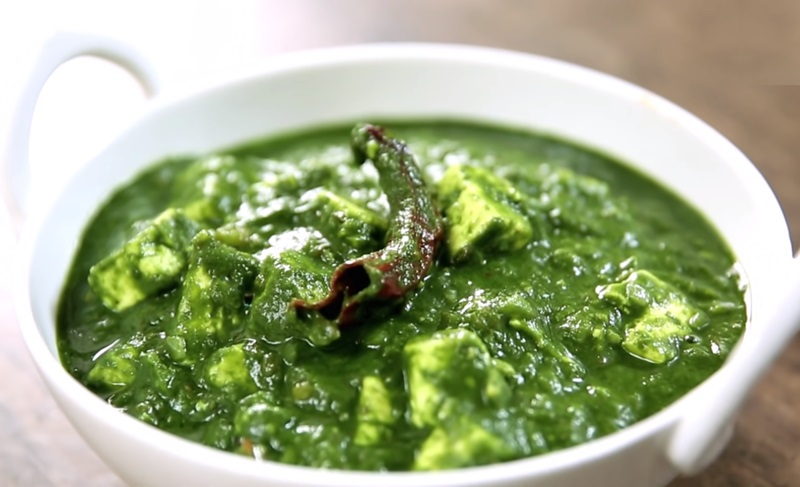
Palak paneer, a culinary gem hailing from the vibrant state of Rajasthan, exemplifies a vegetarian delight blending the richness of spinach (palak) with tender cubes of cottage cheese (paneer). Beyond its vibrant green allure, the dish boasts a symphony of flavors. The preparation involves blanching and pureeing fresh spinach leaves to create a smooth base, complemented by golden-brown, lightly fried paneer cubes. Aromatic spices like cumin, coriander, turmeric, and garam masala elevate the taste while simmering on low heat allows flavors to harmonize. Palak paneer is a wholesome dish, harnessing the nutritional benefits of iron, vitamins, and minerals from spinach, coupled with paneer's protein richness. Served hot with naan bread or steamed rice, its creamy spinach texture and the softness of paneer appeal to both vegetarians and non-vegetarians. A staple in Rajasthan's households, it graces festive occasions and offers comfort in everyday meals. With its unique fusion of flavors and textures, palak paneer is a culinary necessity for those delving into the diverse realm of Rajasthani cuisine.
Aloo Gobi
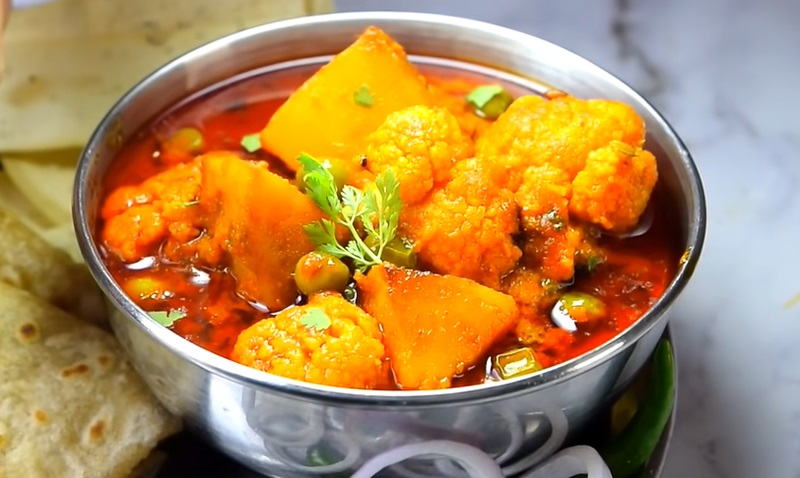
Rajasthani cuisine is known for its rich flavors, vibrant colors, and unique combinations of spices. One popular dish in this cuisine is Aloo Gobi, which is a delicious vegetarian dish made with potatoes (aloo) and cauliflower (gobi). To prepare Aloo Gobi, the potatoes and cauliflower are first cut into small florets and then cooked together with a variety of aromatic spices. Common spices used in this dish include cumin seeds, turmeric, red chili powder, coriander powder, and garam masala. These spices not only add a burst of flavor but also give the dish its distinct yellow hue. The dish is typically cooked in ghee or vegetable oil, which enhances the flavors of the spices. It is often garnished with fresh coriander leaves and served with hot rotis or rice. Aloo Gobi is a comforting and hearty dish that showcases the simplicity and flavors of Rajasthani cuisine. The combination of tender potatoes and cauliflower, along with the fragrant spices, creates a satisfying and flavorful dish that is enjoyed by both locals and tourists alike.
Gujia
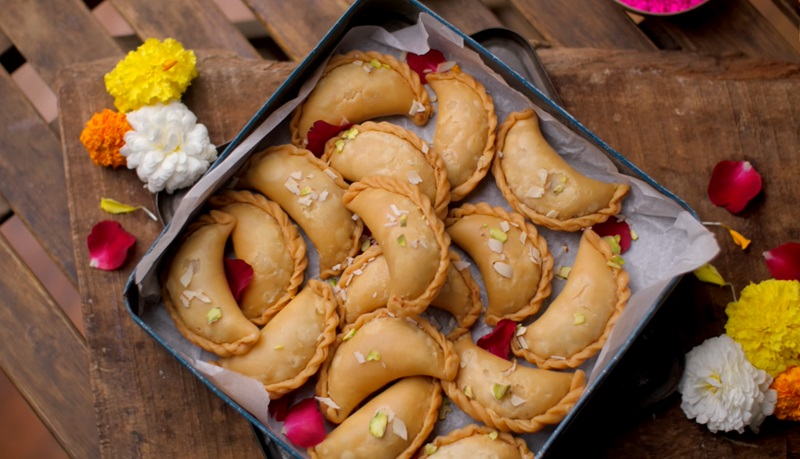
Rajasthani cuisine, renowned for its opulent and lively flavors, showcases cultural richness through the traditional sweet dumpling known as Gujia. This delicacy is a staple during festivals and special occasions, embodying the essence of Rajasthani celebrations. Crafting Gujia involves filling a pastry shell with a decadent blend of khoya (reduced milk), nuts, and sugar. The pastry is meticulously shaped into a crescent or half-moon, sealed, and deep-fried to a golden, crispy perfection. After cooking, the Gujias undergo a sweet transformation as they are delicately dipped in sugar syrup, enhancing the sweetness and lending a glossy finish. Gujia's filling can vary, incorporating elements like coconut, dried fruits, and even savory fillings such as lentils or vegetables. However, the most prevalent and traditional filling is the khoya and nut mixture, offering a sumptuous and creamy texture. Beyond its delectable taste, Gujia holds cultural significance in Rajasthan, often exchanged as a symbol of love and affection during festive occasions like Holi and Diwali. With its crispy outer shell and sweet, indulgent filling, Gujia stands as a delightful treat cherished by individuals of all ages.
Imarti
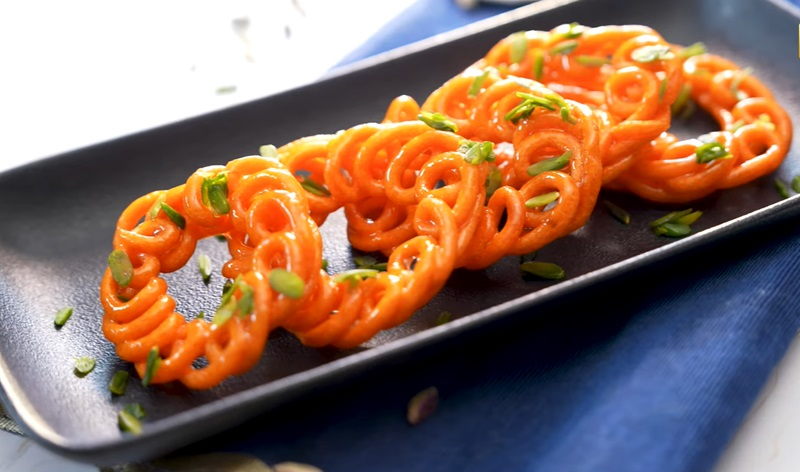
Imarti is a traditional Rajasthani sweet dish that is popularly served during festivals and special occasions. It is made from fermented urad dal (black lentils) batter, which is deep-fried in ghee (clarified butter) until it turns golden and crispy. The fried imartis are then soaked in a sugar syrup infused with saffron and cardamom, giving them a delightful aroma and a rich, sweet flavor. Imartis are known for their distinctive shape, which resembles a flower with interlaced petals. This intricate design is achieved by pouring the batter into a piping bag with a special nozzle and skillfully swirling it in a circular motion into hot ghee. The texture of imartis is soft and spongy on the inside, while the outer layer remains crisp. The sweet and syrupy taste of imartis makes them a delightful treat that is enjoyed by people of all ages. They are often garnished with chopped nuts like pistachios or almonds, adding an extra crunch and a touch of elegance to the dish. Imarti is not only a beloved dessert in Rajasthan but also a symbol of the rich culinary heritage of the region. Its unique flavors and beautiful presentation make it a must-try dish for anyone looking to experience the authentic taste of Rajasthani cuisine.
Malpua
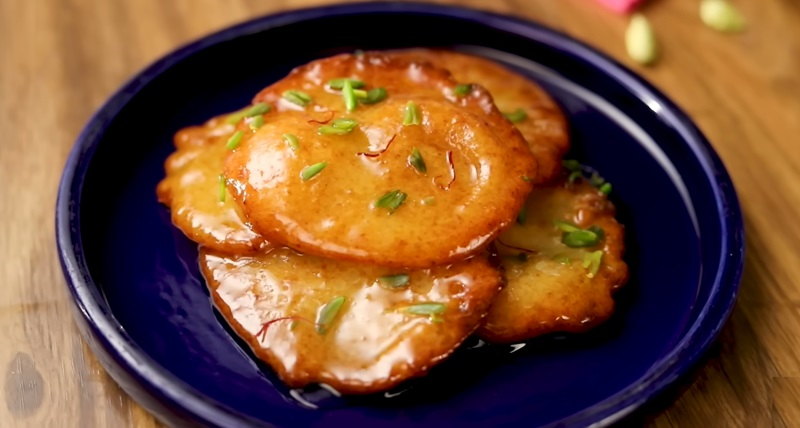
Malpua, a cherished traditional dessert in Rajasthani cuisine, manifests as a sweet, deep-fried pancake born from a batter concocted with flour, milk, and sugar. Infused with the aromatic essence of cardamom and occasionally saffron, malpua stands out with its unique taste. The preparation involves creating a thick batter, blending flour, milk, and sugar. Spooned into hot ghee or oil, the batter undergoes a transformative frying process until achieving a golden-brown hue. Post-frying, malpua takes a sweet plunge into sugar syrup, acquiring a delightfully sweet and sticky texture. Commonly served warm, malpua receives a finishing touch with garnishes of nuts like almonds or pistachios, and sometimes a dollop of thickened milk or rabri. This indulgent dessert is a festive favorite, particularly during celebrations like Holi and Diwali.
Panjiri
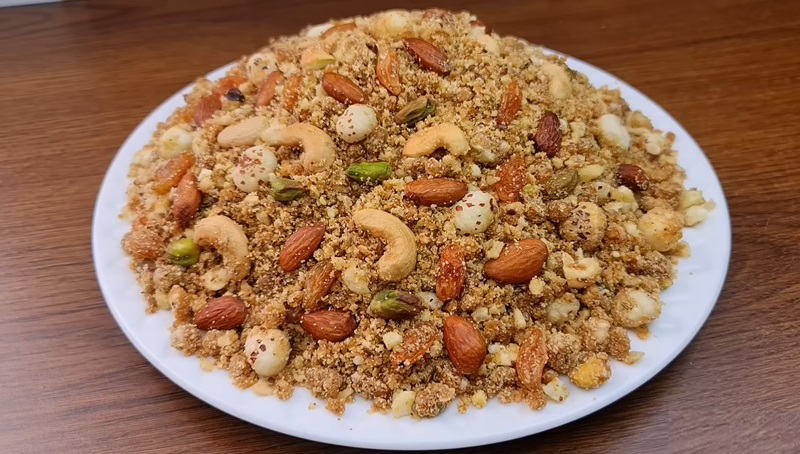
Panjiri, a culinary gem in Rajasthani cuisine, not only tantalizes the taste buds but also carries immense cultural significance within the region. This delectable sweet dish is crafted primarily from wheat flour, ghee (clarified butter), sugar, and an assortment of dry fruits and nuts, making it a popular choice during special occasions like festivals and weddings. The art of making Panjiri involves roasting wheat flour in ghee until it achieves a golden-brown hue and releases a delightful aroma. The roasted flour is then mixed with powdered sugar and an array of chopped dry fruits, including almonds, cashews, pistachios, and raisins, imparting Panjiri with its distinctive crunchy texture and rich flavors. To elevate the taste, a pinch of cardamom powder and edible gum are often added. Panjiri transcends being just a delectable treat; it is considered to offer various health benefits. Known to provide warmth to the body and boost energy levels, Panjiri is particularly favored during the winter season. Additionally, the inclusion of dry fruits and nuts adds nutritional value to this dish. In Rajasthani culture, Panjiri holds cultural significance, often being offered as prasad (religious offering) in temples and distributed among devotees.
Baingan Bharta

Baingan bharta is a popular Rajasthani dish that is loved for its smoky and aromatic flavors. It is made from roasted eggplants that are mashed and cooked with a blend of spices, resulting in a rich and flavorful dish. The preparation of baingan bharta involves charring the eggplant over an open flame until the skin turns black and the flesh becomes soft and smoky. Once roasted, the eggplant is peeled, mashed, and cooked with onions, tomatoes, garlic, ginger, and a variety of spices such as cumin, coriander, turmeric, and chili powder. The dish is usually garnished with fresh coriander leaves and served with roti or rice. The smoky flavor of the roasted eggplant combined with the aromatic spices gives baingan bharta a unique and delightful taste.
Makhan Bada
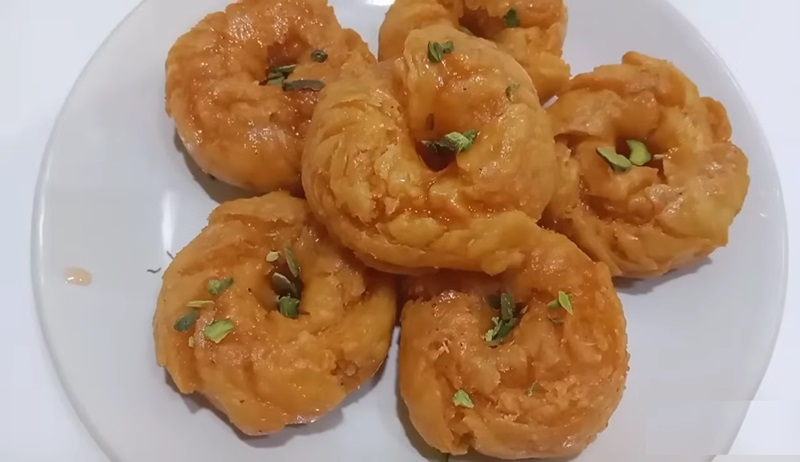
Makhan Bada is a traditional Indian sweet, originating from the state of Rajasthan. This delectable dessert is crafted from key ingredients like ghee, sugar, and besan (gram flour). The mixture is meticulously shaped into small rounds and deep-fried until golden brown, imparting a crispy texture to the outer layer. Once fried, these golden delights are immersed in a sugar syrup, allowing them to absorb sweetness and achieve a soft, syrupy interior. Makhan Bada is often flavored with cardamom or saffron, enhancing its aromatic profile. This sweet treat is widely enjoyed not just in Rajasthan but all over India, offering a delightful blend of textures and flavors that make it a favorite during festive occasions and special celebrations.
Rabri
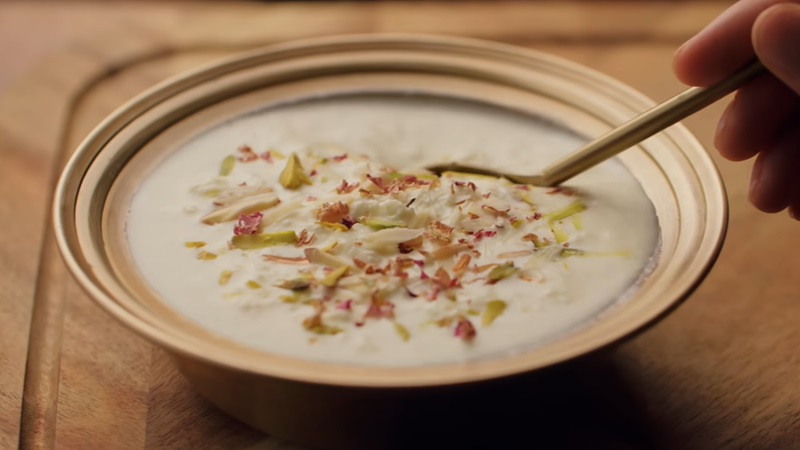
Rabri is a traditional and popular sweet dish popular in the Rajasthani cuisine. It is a rich and creamy dessert made by simmering milk for a long period of time until it reduces and thickens. The milk is boiled until it forms a layer of cream on top, which is then scraped off and added back to the milk. This process is repeated several times to achieve the desired consistency and flavor. The addition of saffron, cardamom, and nuts like almonds and pistachios gives Rabri its distinct aroma and taste. It is often garnished with rose petals, silver leaf, or edible gold to enhance its visual appeal. Rabri is typically enjoyed during festive occasions, weddings, and celebrations. It is loved by people of all ages for its creamy texture, sweetness, and the burst of flavors it offers.
Besan Chakki
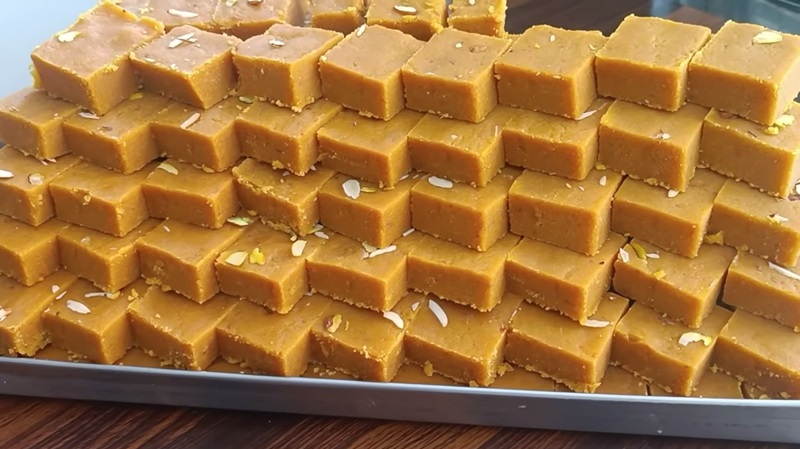
Rajasthani cuisine, renowned for its opulent flavors and distinctive spice blends, features the beloved Besan Chakki. This dish is characterized by a creamy texture derived from the amalgamation of sugar and the fundamental mixture, khoya. The concoction is heated until the milk solidifies and is then molded into various shapes—diamonds, squares, or occasional rounds. Garnished with sliced or chopped almonds and pistachios, it is sometimes colloquially referred to as the "Indian cheesecake," despite the absence of cheese. Besan Chakki showcases delightful variations, incorporating flavors like apricot, mango, and coconut. The inclusion of besan contributes to a smooth texture, rendering khoya an optional element in this delectable Rajasthani treat.
Motichoor Ka Ladoo
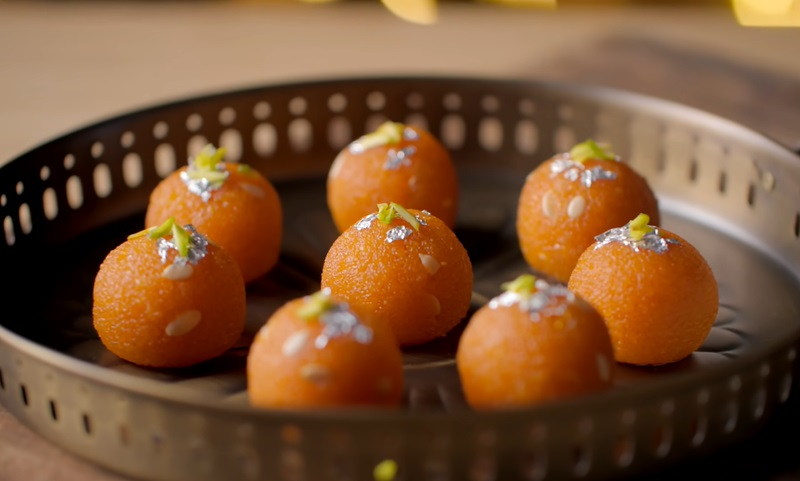
Motichoor ka ladoo is a popular sweet dish from the state of Rajasthan in India. It is made by deep-frying small droplets of besan (gram flour) batter and then shaping them into small balls. These balls are then combined with a sugar syrup infused with saffron, cardamom, and rose water, giving them a distinct flavor and aroma. The name "Motichoor" is derived from the word "moti," which means pearl in Hindi, as the small droplets resemble little pearls. The ladoos have a delicate texture and a rich, sweet taste that makes them a favorite among sweet lovers. Rajasthani cuisine is known for its use of spices and flavors, and Motichoor ka ladoo is no exception. It is often served during festivals, weddings, and other special occasions, adding a touch of sweetness and celebration to the festivities. The dish reflects the rich culinary heritage of Rajasthan, where sweets hold a significant place in the cuisine. It represents the artistry and skill of the local confectioners who have perfected the art of making this delectable treat.






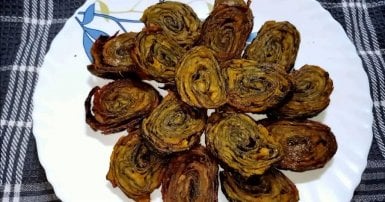
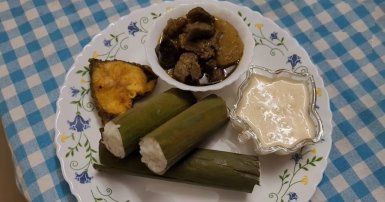
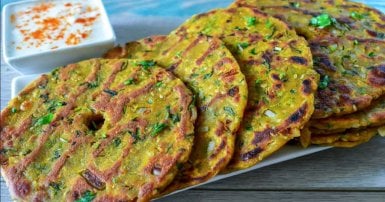
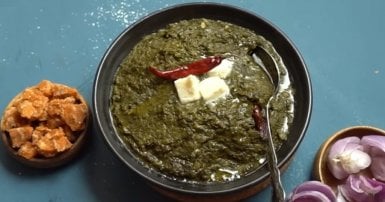
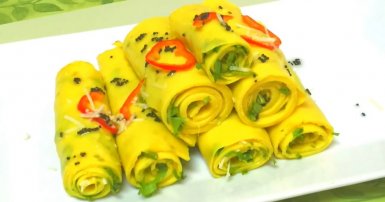
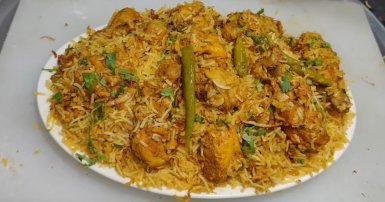

-1709813013.jpg)


